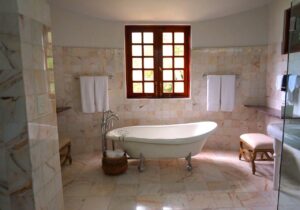What are Walk-In Tubs?
Walk-in tubs, often overshadowed by the more traditional soaking and whirlpool bathtubs, carve out a niche for themselves with unmatched accessibility and safety features. This unique appeal sets them apart in the diverse world of bathroom fixtures, offering a specialized experience that distinguishes walk-in tubs as a category in their own right. Key varieties within this niche include door-in tubs, sit-in tubs, and wheelchair-accessible tubs, each known for their specific benefits.
The Low-Threshold walk-in tub also stands out, offering easier access while still providing a deep, comfortable soak for users. Delving deeper, each type of walk-in tub presents its own set of features, installation requirements, therapeutic benefits, and considerations for space and user needs. The following sections will explore these aspects in detail, providing a comprehensive understanding of what makes walk-in tubs a crucial addition for those prioritizing safety and accessibility in their bathing experience.
The types of tubs

The bathtub market is rich with a variety of options, each designed to cater to different needs, preferences, and aesthetic desires. From the vintage allure of Clawfoot tubs that whisk you away to a bygone era, to Soaking tubs designed for the deepest, most tranquil escape possible. Whirlpool tubs take relaxation to the next level with therapeutic water jets, providing a soothing, massage-like experience that is perfect for unwinding after a long day.
For those with mobility concerns or in need of easier access, Walk-in tubs offer a practical solution, featuring doors that allow for easy entry and exit without the challenge of climbing over a traditional tub side. Each type of tub brings its own unique set of features and benefits, ensuring that there is an ideal option for every bathroom and user. Whether you’re drawn to the therapeutic benefits of a whirlpool, the accessibility features of a walk-in tub, or the deep, immersive relaxation offered by a soaking tub, the choice of tub can greatly enhance the comfort, functionality, and style of your bathroom.
With options ranging from the elegantly simple to the luxuriously functional, finding the perfect tub to suit your bathing needs and preferences is key to creating your ideal bathroom sanctuary.
Clawfoot tubs with distinct vintage style
Clawfoot tubs are the epitome of vintage elegance, featuring a timeless design that adds a luxurious touch to any bathroom. Supported by four ornate feet, these freestanding tubs serve as a stunning centerpiece, effortlessly elevating the room’s aesthetic. Ideal for those who cherish the allure of antique decor, clawfoot tubs not only offer a bathing space but also an immersive experience reminiscent of a lavish bygone era.
Soaking tubs designed for deep relaxation
Soaking tubs are meticulously designed to provide the deepest level of relaxation possible. With their generous depths, these tubs allow for full-body immersion, creating a peaceful sanctuary for those seeking to escape the hustle and bustle of daily life. The emphasis on simplicity and comfort makes soaking tubs the perfect retreat for serene, undisturbed bathing, soothing both the body and the soul.
Whirlpool tubs with built-in water jets for massage
Whirlpool tubs transform your bathroom into a personal spa, featuring built-in water jets that deliver therapeutic massages. These tubs are engineered to alleviate sore muscles and enhance relaxation through the power of hydrotherapy. For individuals seeking a tub that offers both a calming soak and the invigorating effects of a massage, whirlpool models provide a luxurious, multifunctional solution for a rejuvenating bathing experience.
Walk-in tubs for accessibility concerns
Walk-in tubs are specifically designed with accessibility and safety in mind, catering to individuals with mobility challenges or those who prioritize ease of use in their bathing experience. Equipped with a side door, these tubs allow for effortless entry and exit, eliminating the need to navigate a high tub wall. With features like handrails, non-slip floors, and comfortable seating, walk-in tubs offer a secure, accessible bathing option, ensuring peace of mind for seniors and those with disabilities.
What are Bathtubs Made of?

Bathtubs come in a variety of materials, each with its own set of benefits and aesthetic qualities. Fiberglass and Acrylic are widely chosen for their affordability, lightweight nature, and flexibility in design, making them ideal for a wide range of bathroom styles. Cast Iron bathtubs are celebrated for their durability and classic beauty, along with their excellent heat retention capabilities, providing a luxurious soaking experience.
Cast Polymer offers the elegance of natural stone without the hefty price tag, blending seamlessly into upscale bathroom designs. For those seeking a unique and artisanal feel, bathtubs made of Ceramic, Stone, and Wood stand out for their exceptional craftsmanship and natural beauty, though they may require more in terms of maintenance and care. Porcelain over Steel (Enameled Steel) combines the robustness of steel with the sleek, easy-to-clean surface of porcelain, creating a durable and practical choice for everyday use.
Each material presents its own advantages, from ease of installation and maintenance to impact on the overall aesthetic and atmosphere of the bathroom.
Fiberglass
Fiberglass stands out for its lightweight nature and cost-effectiveness, making it a popular choice for those seeking both affordability and ease of installation. Composed of woven fiberglass cloth and resin, it forms a sleek, smooth surface that’s straightforward to clean. However, it’s worth noting that fiberglass may be less durable than some alternatives, necessitating careful usage to avoid damage over time.
Acrylic
Acrylic tubs are celebrated for their long-lasting durability and high-gloss finish, which beautifully mimics more luxurious materials. This material is uniquely resistant to fading and staining and is reinforced with fiberglass, enhancing its structural integrity. Its non-porous surface simplifies cleaning and maintenance, preserving its shine for many years.
Cast Iron

Cast Iron bathtubs are synonymous with durability and classic elegance. Known for their substantial weight, these tubs excel in heat retention, ensuring bath water stays warm longer. The enamel coating offers robust resistance to scratches and chips, though the weight of cast iron demands careful consideration during the installation process.
Cast Polymer
Cast Polymer tubs offer the aesthetic appeal of natural stone, marble, or granite without the associated costs and upkeep. These bathtubs are crafted from a blend of crushed stone and resins, available in various finishes and hues, allowing for seamless integration into any bathroom design.
Ceramic

Ceramic tubs, made from kiln-fired clay and finished with a glaze, provide a sturdy and durable bathing solution. This material enables custom designs and a high degree of customization, adding an artisanal flair to the bathroom. Ceramic is wear-resistant and easy to clean, though it typically requires professional handling for installation.
Stone
Stone bathtubs, each carved from a single piece of natural stone, epitomize luxury and uniqueness. These one-of-a-kind tubs showcase the inherent beauty of the stone, with its natural patterns adding to the tub’s allure. While stone tubs are exceptionally durable and retain heat well, they are notably heavy and demand a robust support structure.
Wood

Wood bathtubs bring a natural and warm ambiance to the bathroom, reminiscent of a tranquil spa. Carefully treated and sealed to resist water, wooden tubs need regular maintenance to preserve their beauty and functionality. Their natural insulation properties make them excellent at keeping bath water warm for extended periods.
Porcelain over Steel (Enameled Steel)
Porcelain over Steel (Enameled Steel) combines the durability of steel with a glossy, porcelain finish. This material resists scratches, chips, and stains, offering a durable, easy-to-clean option for daily use. While lighter than cast iron, enameled steel tubs still provide satisfactory heat retention and a timeless aesthetic that complements a variety of bathroom decors.
Related: How Long Do Hot Tubs Take to Heat Up?
Key considerations for choosing a tub

Choosing the perfect bathtub requires thoughtful consideration of several key factors to ensure it meets your needs, fits your space, and aligns with your budget. The size and space of your bathroom are foundational considerations, as they determine what tub types can be comfortably accommodated. It’s essential to select a tub that enhances the bathroom’s functionality without hindering movement or accessibility.
Budget and cost are also critical, as they influence the materials and tub features you can afford, affecting the overall selection process. Moreover, identifying the desired features in a tub, whether it’s therapeutic jets, accessibility options, or a particular size for deep soaking, helps refine your options to those that best suit your personal preferences and lifestyle. Lastly, the style and aesthetics of the tub should seamlessly integrate with your bathroom’s existing decor, contributing positively to the space’s ambiance.
Whether you’re drawn to a modern, sleek design or the classic elegance of a freestanding tub, ensuring a harmonious match with your bathroom’s theme is key. Balancing these considerations—size and space, budget and cost, desired features, and style and aesthetics—will guide you to the ideal bathtub that satisfies both your practical requirements and aesthetic desires, making your bathroom a more inviting and relaxing space.
Size and space of the bathroom
The size and space of your bathroom are critical factors in selecting the right bathtub. Accurate measurements and a clear understanding of the available space ensure that the chosen tub fits perfectly, enhancing the bathroom’s functionality without compromising on comfort or access to other fixtures. Consider the layout and dimensions carefully to select a tub that complements the space effectively.
Budget and cost of tub models
Budget and cost considerations are essential in guiding your tub selection. With a wide range of prices influenced by materials, features, and brand reputation, establishing a budget upfront can help focus your search on affordable options. It’s important to balance cost with quality, seeking out the best value that meets both your financial constraints and bathing needs.
Desired features (e.g., jets, size, accessibility)
Choosing a bathtub based on desired features allows for a customized bathing experience tailored to your preferences and requirements. Options like therapeutic jets, spacious sizes for deep soaking, and accessibility features such as low thresholds and grab bars can significantly enhance comfort and usability. Prioritizing these features ensures the tub meets all your needs for relaxation and convenience.
Style and aesthetics to match bathroom decor
The style and aesthetics of your bathtub should seamlessly blend with your bathroom’s existing decor, creating a cohesive and attractive space. Whether you’re drawn to a sleek, modern design or the timeless appeal of a classic style, the material, shape, and color of the tub can significantly impact the overall look and feel of your bathroom. Choosing a tub that reflects your personal aesthetic contributes to a harmonious and inviting bathroom environment.
Tub installation process

The installation process of a bathtub is a crucial phase that demands precision and expertise to ensure the tub’s functionality and safety. It begins with measuring the bathroom area accurately to guarantee the selected tub fits perfectly. Following this, the positioning of the tub in the allocated space is critical, as is securing it firmly to avoid any movement that could lead to damage or leaks.
The process also involves making the necessary plumbing connections, including water supply and drainage, to ensure a seamless operation. For bathtubs that come with additional features, such as whirlpool models, an electrical setup might be necessary to power jets and other functionalities. Due to the complexity and technical precision required, seeking professional installation is strongly advised.
Experienced installers can efficiently handle the intricacies of fitting, plumbing, and electrical connections, ensuring that your bathtub is installed correctly and operates flawlessly. This not only provides peace of mind but also safeguards the longevity and performance of your bathtub, making it a worthwhile investment for your home.
Professional installation is recommended for accuracy
Professional tub installation is crucial for ensuring the accuracy and safety of your bathtub installation. Experts in the field utilize their skills and precision to guarantee that the tub is installed flawlessly, operates efficiently, and meets all safety regulations. This level of professionalism significantly reduces the risk of installation errors, potential damage, or future operational issues, making it a wise investment for the longevity of your bathtub.
Steps include measuring, positioning, securing, and plumbing connections
The installation process involves a series of detailed steps: measuring the available space to confirm fit, positioning the bathtub correctly within the bathroom’s layout, securing the bathtub to prevent any movement, and making the necessary plumbing connections for water supply and drainage. Each of these steps is vital to the installation’s success, demanding meticulous attention to detail and a thorough understanding of plumbing principles to ensure a smooth and functional setup.
Electrical setup for whirlpool and air tubs
For bathtubs featuring advanced functionalities, such as whirlpools and air tubs, an electrical setup is an integral component of the installation process. This step involves establishing safe and efficient electrical connections to power the tub’s jets and additional features. The complexity of integrating electrical systems with water-based appliances underscores the importance of professional installation, ensuring that all electrical components are correctly installed for safe, reliable operation.
Maintenance of tubs

Maintaining your bathtub is key to preserving its longevity, appearance, and functionality. Regular cleaning with gentle, non-abrasive cleaners is essential to prevent the buildup of soap scum, mildew, and stains that can detract from your tub’s surface. Equally important are periodic inspections to check for leaks or damage, allowing for early intervention and avoiding more extensive repairs later.
Caulking maintenance is crucial as well, ensuring a watertight seal around the tub to protect against water damage to floors and walls. For materials like acrylic or fiberglass, addressing surface scratches or chips in a timely manner with appropriate repair kits can help maintain the tub’s integrity and aesthetics. By committing to these maintenance practices, you can ensure your bathtub remains a clean, functional, and attractive feature of your bathroom for years to come, making regular upkeep a valuable investment in your home’s comfort and value.
Regular cleaning with non-abrasive cleaners
Regular cleaning plays a pivotal role in the upkeep of your bathtub, with non-abrasive cleaners being the go-to choice to protect the tub’s surface. This approach prevents the accumulation of soap scum, mildew, and stains, ensuring the bathtub maintains its aesthetic appeal and hygienic conditions without compromising the finish.
Periodic inspection for leaks or damage
Periodic inspections are essential for identifying any leaks or damage early on. Timely detection allows for prompt repairs, averting the progression of minor issues into more significant, costly repairs. Regular checks safeguard the bathtub’s structural integrity and operational functionality, contributing to a safer bathing environment.
Caulking maintenance to prevent water damage
Caulking maintenance is crucial in protecting your bathroom against water damage. Over time, caulk can deteriorate, leading to gaps that allow water to seep through. Inspecting and replacing caulking as necessary ensures a secure, watertight seal around the bathtub, preventing moisture-related issues such as mold, mildew, and potential structural damage.
Handling surface scratches or chips in material
Addressing surface scratches or chips in materials like acrylic or fiberglass promptly is vital for maintaining the bathtub’s condition. Specialized repair kits enable effective restoration of the surface, mitigating the impact of minor blemishes. Promptly repairing these imperfections not only enhances the tub’s aesthetics but also prevents the spread of damage, ensuring the longevity and beauty of your bathtub.
Closing Thoughts
Selecting the perfect bathtub transcends mere aesthetics; it’s an investment in your daily well-being and relaxation. From the vintage charm of clawfoot tubs to the therapeutic benefits of whirlpool baths, each type caters to distinct preferences and requirements. The choice of material significantly influences the tub’s longevity, ease of maintenance, and visual appeal, underscoring the importance of choosing one that complements your lifestyle and bathroom decor.
Installation and ongoing maintenance are critical to ensuring your bathtub remains a sanctuary of comfort and serenity for many years. By carefully considering aspects such as space, budget, desired features, and aesthetics, you can make a well-informed selection that enhances your bathing experience and adds significant value to your home. Ultimately, the ideal bathtub not only fits your physical space but also enriches your life, transforming each bathing moment into an experience of unparalleled tranquility.
Looking for walk-in tub installers? Contact us today!
